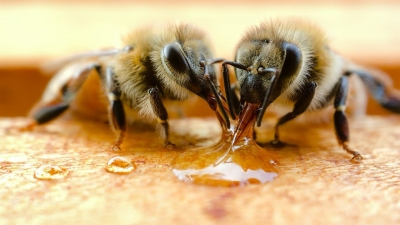
The wax produced by bees is used in making honeycombs consisting of six-sided cells into each of which the queen bee lays an egg that will eventually give birth to an insect. Other cells in the honeycomb act as storage places for honey.
Bees produce wax in very thin sheets from eight glands on their abdomens. It takes some 1,250 of these sheets to make up one gramme of wax. We can imagine the amount of hard work that goes into the construction of a honeycomb. Not only does the bee produce the wax, but it also shapes it into the hexagonal cell.
The honey is nectar from flowers which has been gathered concentrated and digested by the bees. The honey still has the scent of the flowers where the bees first found it. The queen bee is an extremely fertile animal. This insect is no more than 2 centimeters long but lays an average of 2,500 eggs a day at the rate of two eggs every minute. It does this throughout its entire life, accumulating a total of 2 million eggs.
Each egg is placed inside a hexagonal cell. If the larvae as the infant bees are called are fed on a substance known as royal jelly, they too, become queens. If they are just fed on pollen they grow into ordinary bees. But a beehive can contain only one queen. So the first queen bee to emerge from the cells and drives the old queen out. The old queen leaves with a swarm of bees still loyal to her to start another hive elsewhere.
Once the new queen begins her reign she carries out what is called her nuptial flight. As she flies through the air she is accompanied by male bees known as drones. The queen bee flies higher and higher and only the strongest of the drones can catch her and mate with her, the queen bee return from her nuptial flight fertilized and sets to laying eggs assisted by a group of bees who feed her and look after all her needs.
Picture Credit : Google
